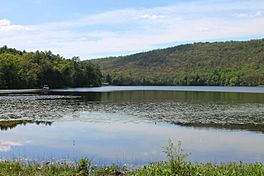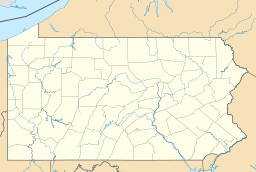Lily Lake (Pennsylvania) facts for kids
Quick facts for kids Lily Lake |
|
|---|---|
| Long Pond, Beach Pond | |

The western part of Lily Lake
|
|
| Location | Luzerne County, Pennsylvania |
| Coordinates | 41°08′31″N 76°04′59″W / 41.142°N 76.083°W |
| Type | glacial lake |
| Primary inflows | Pond Creek |
| Primary outflows | Pond Creek |
| Max. length | 1 mile (1.6 km) |
| Max. width | 0.5 miles (0.80 km) |
| Surface area | 160 acres (65 ha) |
| Surface elevation | 1,010 feet (310 m) |
| Frozen | as late as March 15 |
Lily Lake is a beautiful natural lake located in Luzerne County, Pennsylvania. It's also known by other names like Long Pond or Beach Pond. This lake covers about 160 acres (65 hectares) and is connected to Pond Creek.
Lily Lake was formed naturally by glaciers in Slocum Township and Conyngham Township. It's considered an important natural area in Luzerne County. Many different kinds of fish live here, including alewives and bluegills. The lake also has a special place where you can launch a boat.
Contents
About Lily Lake's Location and Size
Lily Lake sits high up, about 1,010 feet (308 meters) above sea level. It's quite large, covering about 160 acres (65 hectares). The lake is roughly 1 mile (1.6 kilometers) long and about 0.5 miles (0.8 kilometers) wide at its widest point.
You can find Lily Lake in the United States Geological Survey area called Nanticoke. It's located in Slocum Township and Conyngham Township. The lake is also close to a community called Pond Hill. It's connected to other nearby ponds like Cranberry Pond and Folstown Mud Pond.
Most of the land around Lily Lake, about 93 percent, is owned by the Pennsylvania Fish and Boat Commission. The rest of the land is privately owned. Sometimes, the lake can freeze over, even as late as March. In the past, people described the lake as being shaped like an oval and not suitable for large boats.
History of Lily Lake
Lily Lake was officially added to the Geographic Names Information System on August 2, 1979. This system helps keep track of names for places like lakes and mountains.
The lake has been known as Long Pond for a long time. This name even appeared on a map called Patton's Philadelphia and Suburbs Street and Road Map, which was published in 1984.
Fish have been added to Lily Lake over the years to help keep the fish population healthy. In 1991, brook trout, brown trout, and rainbow trout were put into the lake. Experts from the Pennsylvania Fish and Boat Commission have studied the lake many times. They surveyed it four times between 1994 and 2000, and again in 2013 and 2014. The 2014 study looked at how a type of fish called alewives might be affecting the population of largemouth bass in the lake.
Animals and Plants at Lily Lake
Lily Lake is an important natural area listed on the Luzerne County Natural Areas Inventory. This means it's recognized for its special plants and animals.
Fish Species
In 2013, the Pennsylvania Fish and Boat Commission found eleven different kinds of fish living in Lily Lake. Some of the fish they observed include:
- Alewives: They caught 365 of these fish.
- Bluegills: They found 333 bluegills, ranging from 2 to 9 inches (5 to 23 cm) long.
- Black Crappies: 93 black crappies were seen, from 3 to 16 inches (8 to 41 cm) long.
- Brown Bullheads: 53 brown bullheads were found, 10 to 15 inches (25 to 38 cm) long.
- Golden Shiners: 36 golden shiners were observed, 3 to 10 inches (8 to 25 cm) long.
- Chain Pickerels: 22 chain pickerels were caught, 13 to 25 inches (33 to 64 cm) long.
- Pumpkinseeds: 18 pumpkinseeds were found, 3 to 9 inches (8 to 23 cm) long.
- Yellow Perches: 12 yellow perches were seen, 8 to 13 inches (20 to 33 cm) long.
- Rainbow Trout: 10 rainbow trout from a hatchery were observed.
- Largemouth Bass: 7 largemouth bass were found, 2 to 20 inches (5 to 51 cm) long.
- Northern Pike: 2 northern pike were seen, 20 to 25 inches (51 to 64 cm) long.
After alewives were introduced into Lily Lake, the number of bluegills dropped by 77 percent. Black crappie populations also went down by 79 percent. However, the black crappies that remained were larger than before.
Other Wildlife and Plants
Many interesting insects, like dragonflies and damselflies (called Odonates), live around Lily Lake. Some of these include Aeshna clepsydra, Celithemis eponina, Libellula incesta, Ischnura kellicotti, and Sympetrum semicinctum.
Different types of plants also grow near the lake. These include Bidens discoidea, Myriophyllum heterophyllum, Schoenoplectus torreyi, and Utricularia intermedia. In the past, plants like Elatine minima and Potamogeton robbinsii have also been seen here.
Fun Activities at Lily Lake
Lily Lake is a great place for fishing! You can fish here, and in winter, people sometimes go ice fishing too.
The lake has one place where you can launch your boat. However, there are some rules for boats. Boats longer than 18 feet (5.5 meters) or with engines more powerful than 60 horsepower are not allowed. Also, between noon and sunset from the Saturday before Memorial Day until September 30, boats must travel at slower speeds.
See also






